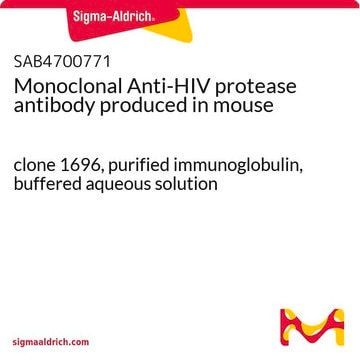H3784
HEPES sodium salt
BioPerformance Certified, suitable for cell culture, ≥99.0%
Synonim(y):
4-(2-Hydroxyethyl)piperazine-1-ethanesulfonic acid sodium salt, N-(2-Hydroxyethyl)piperazine-N′-(2-ethanesulfonic acid) sodium salt
About This Item
Polecane produkty
klasa czystości
BioPerformance Certified
Poziom jakości
Próba
≥99.0%
Postać
powder
warunki przechowywania
dry at room temperature
metody
activity assay: suitable
cell culture | mammalian: suitable
zanieczyszczenia
endotoxin and total aerobic microbial count, tested
kolor
white
pH
10-12 (1 M in water)
przydatny zakres pH
6.8-8.2
pKa (25°C)
7.5
rozpuszczalność
water: 0.1 M, clear, colorless
gęstość
1.19 g/cm3 at 20—25 °C
1.21 g/cm3 at 20—25 °C
absorpcja
≤0.02 at 280 in H2O at 0.1 M
≤0.04 at 260 in H2O at 0.1 M
przydatność
suitable for component for culture media
suitable for molecular biology
Zastosowanie
cell analysis
diagnostic assay manufacturing
general analytical
life science and biopharma
obecność zanieczyszczeń
DNase, RNase, NICKase, protease, none detected
ciąg SMILES
[Na+].OCCN1CCN(CC1)CCS([O-])(=O)=O
InChI
1S/C8H18N2O4S.Na/c11-7-5-9-1-3-10(4-2-9)6-8-15(12,13)14;/h11H,1-8H2,(H,12,13,14);/q;+1/p-1
Klucz InChI
RDZTWEVXRGYCFV-UHFFFAOYSA-M
Szukasz podobnych produktów? Odwiedź Przewodnik dotyczący porównywania produktów
Powiązane kategorie
Opis ogólny
In cell culture, HEPES excels in maintaining stable physiological pH even amidst fluctuating carbon dioxide concentrations, outperforming bicarbonate buffers (NaHCO3). Moreover, HEPES showcases valuable properties in various biological and biochemical processes, such as isoelectric focusing for protein separation and minimal interference in DNA-restriction enzyme reactions, making it indispensable across diverse research applications, including immunoprecipitation, cell lysis, and live cell imaging. Its versatility, exceptional buffering capacity, and minimal interaction with molecules establish HEPES as a key tool in various research domains.
Zastosowanie
- to supplement the HSOF medium
- as a buffer component of HCZB medium in egg and embryo culture
- as a buffer component in cell culture
Cechy i korzyści
- High-purity product for biochemical and biological research
- Tested to confirm low levels of heavy metal contamination, ensuring suitability for various applications
- Highly soluble in water with a useful pH range of 6.8 - 8.2 and pKa of 7.5 at 25 °C
- Suitable for Cell culture
- Tested for Endotoxins and Total Aerobic Microbial Count
- Free from DNase, NICKase, RNase, Endonuclease, Exonuclease and Protease
Postać fizyczna
Inne uwagi
produkt podobny
Kod klasy składowania
11 - Combustible Solids
Klasa zagrożenia wodnego (WGK)
WGK 3
Temperatura zapłonu (°F)
Not applicable
Temperatura zapłonu (°C)
Not applicable
Środki ochrony indywidualnej
Eyeshields, Gloves, type N95 (US)
Certyfikaty analizy (CoA)
Poszukaj Certyfikaty analizy (CoA), wpisując numer partii/serii produktów. Numery serii i partii można znaleźć na etykiecie produktu po słowach „seria” lub „partia”.
Masz już ten produkt?
Dokumenty związane z niedawno zakupionymi produktami zostały zamieszczone w Bibliotece dokumentów.
Klienci oglądali również te produkty
Nasz zespół naukowców ma doświadczenie we wszystkich obszarach badań, w tym w naukach przyrodniczych, materiałoznawstwie, syntezie chemicznej, chromatografii, analityce i wielu innych dziedzinach.
Skontaktuj się z zespołem ds. pomocy technicznej

